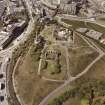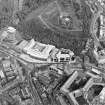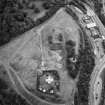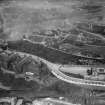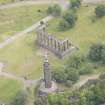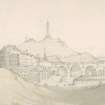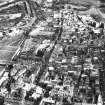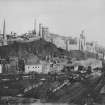Edinburgh, Calton Hill, Nelson's Monument
Commemorative Monument (19th Century), War Memorial (19th Century) (1816)
Site Name Edinburgh, Calton Hill, Nelson's Monument
Classification Commemorative Monument (19th Century), War Memorial (19th Century) (1816)
Alternative Name(s) Greenside; Calton Hill, Off Regent Road, Nelson's Monument
Canmore ID 52378
Site Number NT27SE 348
NGR NT 26252 74107
Datum OSGB36 - NGR
Permalink http://canmore.org.uk/site/52378
- Council Edinburgh, City Of
- Parish Edinburgh (Edinburgh, City Of)
- Former Region Lothian
- Former District City Of Edinburgh
- Former County Midlothian
NT27SE 348 26252 74107
Information from a catalogue slip:
Architect: Robert Burn, (Father of William Burn) begun 1807
NMRS REFERENCE
See Historical File (1.12)
REFERENCE
PLANS:
City Architects Plan Store, drawers Nos. 85 and 91 contains:-
1. Original Plan and Elevation (to which reference already made) of "screen wall and apartments around Nelson's Monument on the Calton Hill". Scale 10 feet to 1 inch. daed 13th May 1814 and signed Thomas Bonnar. Also signed by John Dickson as referring to his estimate "fore furnishing Nelson's Monument".
2.Tracings of December 1855 shewing a New Roof, scale 1" to 1foot. Section of Tower shewing timbers etc., scale 1" to 1 foot. The alterations made in erecting the time ball.
3. Contract Plan shewing Turnstiles at Entrance, scale 2 1/2" to 10 feet, Public Works Office 1886.
4. Block Plan shewing line of Drawin 1898.
5. Tracing to plan shewing new kitchen and bathroom alterations to caretaker's house. City Architects Department 1937.
There are NMRS reproductions of Nos. 1,2 and 5 above see EDD/27/1-3
REFERENCE:
Hugh Cairncross (Robert Burn, Archt)
Edinburgh. Nelson Monument. Specification, 1808
(Edinburgh Evening Courant, July 28, 1808)
(Undated) information in NMRS.
Publication Account (1951)
148. The Nelson Monument, Calton Hill.
In 1806 the citizens of Edinburgh replaced the existing "telegraph" upon the summit of the Calton Hill by a monument in honour of the victor of Trafalgar. This took the form of a stone signal-tower sufficiently lofty to be seen by the shipping in Leith Roads. Designed by Robert Burn, it was completed about 1815 by another architect named Dickson (1). The tower is constructed throughout of droved ashlar with polished dressings, all of Craigleith stone. The base, originally intended for a restaurant but to-day occupied by the keeper, is polygonal on plan with a bastion at each corner and has a battlemented top. Above this rises a circular tower in four tiers containing a spiral stair. The stair leads to a look-out in the form of a medieval bartizan, and continues upwards in a circular cap-house also surmounted by a bartizan. This bartizan carries a vane and the apparatus for a time-signal, the latter added in 1852 to enable ship-masters to set their chronometers. Above the entrance in the E. side of the base are two panels, the lower one bearing the date MDCCCV, the year in which the battle of Trafalgar was fought, and the upper one, which is surmounted by Nelson's crest "Upon waves of the sea, the stern of a Spanish man of war, inscribed San Joseff " - containing the following inscription: TO THE MEMORY OF / VICE-ADMIRAL/ HORATIO LORD VISCOUNT NELSON, / AND OF THE GREAT VICTORY OF TRAFALGAR / TOO DEARLY PURCHASED WITH HIS BLOOD / THE GRATEFUL CITIZENS OF EDINBURGH / HAVE ERECTED THIS MONUMENT: / NOT TO EXPRESS THEIR UNAVAILING SORROW FOR HIS DEATH: / NOR YET TO CELEBRATE THE MATCHLESS GLORIES OF HIS LIFE: / BUT, BY HIS NOBLE EXAMPLE, TO TEACH THEIR SONS / TO EMULATE WHAT THEY ADMIRE AND, LIKE HIM, WHEN DUTY REQUIRES IT, /TO DIE FOR THEIR COUNTRY.
RCAHMS 1951, visited c.1941
(1) Transactions of the Edinburgh Architectural Association, ii, p. 221.
Project (1997)
The Public Monuments and Sculpture Association (http://www.pmsa.org.uk/) set up a National Recording Project in 1997 with the aim of making a survey of public monuments and sculpture in Britain ranging from medieval monuments to the most contemporary works. Information from the Edinburgh project was added to the RCAHMS database in October 2010 and again in 2012.
The PMSA (Public Monuments and Sculpture Association) Edinburgh Sculpture Project has been supported by Eastern Photocolour, Edinburgh College of Art, the Edinburgh World Heritage Trust, Historic Scotland, the Hope Scott Trust, The Old Edinburgh Club, the Pilgrim Trust, the RCAHMS, and the Scottish Archive Network.
Field Visit (4 April 2001)
The monument, a circular tower with windows, resembles an upturned telescope. On the top is a ball and cross-trees, and a parapet with castellations. The base is castellated with gothic style windows. Above the main door is a carved relief of the ship 'San Josef', and the above inscription below.
The original design of the monument was by Alexander Nasmyth, but this was rejected as being too expensive. The commission was passed to Robert Burn and the foundation stone was laid on 21 October 1807, the second anniversary of the Battle of Trafalgar. In 1814-16 the base was enclosed in a five-sided structure by Thomas Bonnar (to Burn's design). The carving of the San Josef was added at this time.
Francis H. Groome in his Gazeteer calls the monument 'one of the ugliest monuments in Edinburgh - the curious butter-churn structure by which public taste saw fit to perpetrate the memory of Lord Nelson.' (1)
Commemorates Admiral Lord Nelson and the battle of Trafalgar.
The San Josef was a Spanish man of war and the flagship of the Spanish admiral Don Josef de Cordova at the Battle of Cape St Vincent in 1797. In this battle Nelson captured the ship and the admiral was killed.
In 1852 a time signal was installed: a ball at the top of the monument which is dropped at twelve noon G.M.T. (one o'clock p.m. in the summer, in conjunction with the gun being fired at Edinburgh Castle). This is to give a signal of the correct time, to the ships in the Forth.
Inspected By : Emma Retson
Inscriptions : Above main door, on top plaque (incised letters):
TO THE MEMORY OF / VICE ADMIRAL / HORATIO LORD VISCOUNT NELSON, / AND OF THE GREAT VICTORY OF TRAFALGAR, / TOO DEARLY PURCHASED WITH HIS BLOOD, / THE GRATEFUL CITIZENS OF EDINBURGH / HAVE ERECTED THIS MONUMENT: / NOT TO EXPRESS THEIR UNAVAILING SORROW FOR HIS DEATH; / NOR YET TO CELEBRATE THE MATCHLESS GLORIES OF HIS LIFE; BUT BY HIS NOBLE EXAMPLE, TO TEACH THEIR SONS / TO EMULATE WHAT THEY ADMIRE, AND, LIKE HIM, WHEN DUTY REQUIRES IT, / TO DIE FOR THEIR COUNTRY
On bottom plaque (incised letters):
A.D.MDCCCV. [1805, the date of the Battle of Trafalgar]
Signatures : None Visible
Design period : 1807 (monument) / 1814-1816 (base added)
Information from Public Monuments and Sculpture Association (PMSA Work Ref : EDIN0469)
Field Visit (31 May 2002)
Cast relief (in plaster) of ships, with painted details of sea, ship, cannon, sails and flags of Saint George, including union jack in top left corner. Ship set into plaster frame painted as walls.
Inscriptions : Central relief (lower case lettering painted gold and black):
England expects every man this day will do this duty.
Signatures : None
Information from Public Monuments and Sculpture Association (PMSA Work Ref : EDIN0470)
Field Visit (6 May 2002)
Bust of Horatio Nelson in naval uniform.
Inspected By : AA. Campbell
Inscriptions : None
Signatures : None
Information from Public Monuments and Sculpture Association (PMSA Work Ref : EDIN0471)
Archaeological Evaluation (8 September 2016)
Addyman Archaeology was commissioned by the City of Edinburgh Council to undertake an archaeological evaluation of an uncovered stone feature. The feature was partially exposed during the formation of a series of planting beds to the east of Nelson's Monument on Calton Hill. A trench was excavated across the top of the feature to identify its extent and purpose. The feature was formed from a deep cut into the bedrock of the hill, forming a large square chamber. The chamber was lined with dry stone and sealed with a 1m square stone capping. Two ceramic pipes ran in/out of the chamber; one of these was possibly from a down pipe and the other was perhaps an overflow. The feature proved to be drainage related. Its full purpose was not clear, but it was possibly a cistern tank for collecting rainwater.
Information from Kenneth Macfayden (Addyman Archaeology) September 2016. OASIS ID: addymana1-262216





























































